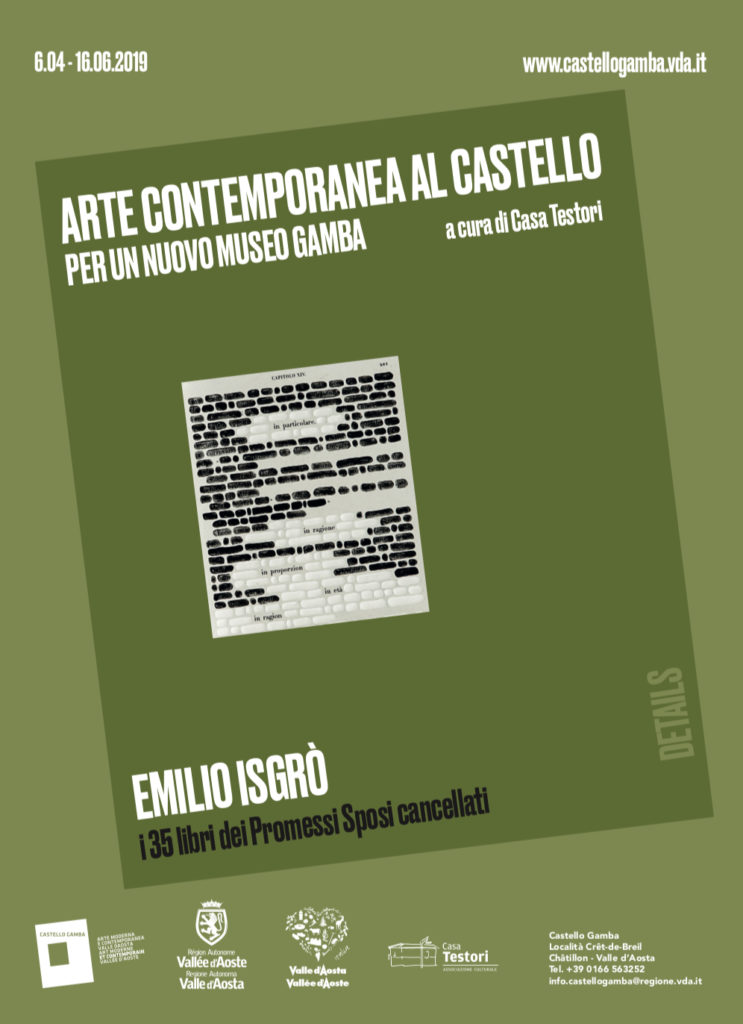|
|
[English below]
«Cancellandola, mi sono accorto di come la scrittura manzoniana sia quanto di più potente e sorgivo abbia offerto la nostra letteratura dopo Dante. Giacché in Manzoni anche la cultura si fa natura».
 Al centro dell’esposizione è posta l’opera più imponente realizzata da Emilio Isgrò: i 35 libri cancellati dedicati alle pagine più celebri de I Promessi Sposi di Alessandro Manzoni. I Promessi Sposi cancellati per venticinque lettori e dieci appestati è un’opera realizzata nel 2016 appositamente per essere esposta a Casa Manzoni, a Milano. È qui presentata, non solo per la sua imponente bellezza e perché esemplificativa della poetica dell’artista e delle sue celebri cancellature, ma perché utile a comprendere la portata creativa che ha avuto nell’artista l’intuizione sulla centralità della parola, ben espressa nell’opera di Isgrò conservata al Castello Gamba e visibile nel percorso del Museo. Al centro dell’esposizione è posta l’opera più imponente realizzata da Emilio Isgrò: i 35 libri cancellati dedicati alle pagine più celebri de I Promessi Sposi di Alessandro Manzoni. I Promessi Sposi cancellati per venticinque lettori e dieci appestati è un’opera realizzata nel 2016 appositamente per essere esposta a Casa Manzoni, a Milano. È qui presentata, non solo per la sua imponente bellezza e perché esemplificativa della poetica dell’artista e delle sue celebri cancellature, ma perché utile a comprendere la portata creativa che ha avuto nell’artista l’intuizione sulla centralità della parola, ben espressa nell’opera di Isgrò conservata al Castello Gamba e visibile nel percorso del Museo.
L’opera è composta da 35 copie del romanzo, aperte su pagine emblematiche, e presentate in altrettante teche di plexiglass. I volumi utilizzati sono la ristampa anastatica della prima edizione del romanzo nella sua versione definitiva (la cosiddetta Quarantana), edizione che Manzoni aveva fatto illustrare da Alessandro Gonin, fornendogli precise indicazioni. Isgrò, artista siciliano trapiantato a Milano, è intervenuto sulle 70 pagine con un’operazione a lui consueta: ha cancellato quasi tutto il testo con inchiostro nero o tempera bianca, facendo sopravvivere solo alcune parole chiave, perché salvate o lasciate emergere dalla trasparenza del segno. Sono proprio queste parole salvate a ricreare un nuovo testo o, meglio, a darci una sintetica e poetica chiave di lettura del passaggio scelto. Quello che sembrerebbe oltraggio si scopre così un atto d’amore. L’intervento di Isgrò ci fa precipitare nel cuore del testo e ci fa capire la grandezza della scrittura manzoniana.
È così che, quando il silenzio si fa necessario, nulla si può dire, o aggiungere di nuovo, rimangono solo le virgole, a segnare il passaggio del tempo e a rassicurarci che qualcosa di indescrivibile sta accadendo. Più spesso si salvano poche parole sufficienti ad evocare l’intero capitolo, come la conversione dell’Innominato: “dio, Io, Dio”. Talvolta l’intervento è più pittorico: è così che compaiono le due anime della Monaca di Monza, contemporaneamente bianca e nera. Del resto, la bellezza pittorica delle pagine ricreate non viene mai meno ed è una componente essenziale dell’armonia che trasmette l’opera. Le cancellature danno un ritmo musicale alle pagine e l’alternanza dei bianchi e dei neri è poetica in sé. Ma sono certamente le parole di Manzoni, sfrondate e levigate come pietre piccole e preziose, a brillare tra i solchi creati dall’artista, restituendoci la potenza evocativa maggiore. Tre semplici “e”, superstiti nel vuoto della pagina, dilatano l’aspettativa di un lieto fine insita nel romanzo, mentre frasi completamente nuove, come quella nata dalle indicazioni di Fra Cristoforo, “direte barca rispondete amore”, sciolgono il confine tra scrittura e arti figurative. Perché è in questa sinestesia tra i linguaggi che sta la grandezza di quest’opera. Il romanzo in generale e, come sottolineava Giovanni Testori, Manzoni in particolare, conduce il lettore, parola dopo parola, fino al culmine del sentimento, della commozione, rabbia o pietà che è in grado di suscitare, con i tempi della lingua e della narrazione. L’opera d’arte accade, al contrario, in un istante, di fronte allo spettatore: è come se potessimo leggere in un sol colpo un intero romanzo, diceva Testori. Scrittura e arte figurativa hanno tempi lontanissimi di fruizione: l’una ci può far correre o passeggiare, l’altra ci costringe a un immediato tuffo olimpionico. Ecco, con le sue cancellature, Isgrò imprime alla letteratura i tempi vertiginosi dell’arte, permettendoci di cogliere l’essenza di un intero capitolo in un colpo d’occhio, ma, al contempo, con un’opera come questa, ci riporta, libro dopo libro, un personaggio o fotogramma via l’altro, ai tempi tipici della lettura, fatti di comprensione, apprezzamento, stupore e profonda immedesimazione.
Emilio Isgrò: the 35 books of The Betrothed, deleted
«In deleting the work, I came to realise how Manzoni’s writing being so powerful and pure has contributed to our literature second only to Dante. Since in Manzoni, culture too becomes nature».
At the center of the exhibition Emilio Isgrò’s most impressive work is exhibited: the 35 deleted books dedicated to the most famous pages of I Promessi Sposi by Alessandro Manzoni. I Promessi Sposi cancellati per venticinque lettori and dieci appestati is a work from 2016, specifically created for display at Casa Manzoni, in Milan. It is shown here, not just for its magnificent beauty and because it is illustrative of the poetics of the artist and his renowned deletions, but because it is a useful tool for understanding the creative effect that the intuition of the centrality of the word had on the artist. This is well expressed in the work of Isgrò housed in Castello Gamba and accessible on a tour of the Museum.
The work is compiled of 35 copies of the novel, opened at symbolic pages, and exhibited in individual plexiglass display cases. The volumes used are an anastatic reprint of the novel’s first edition in its final version (Quarantana); the edition that Manzoni had Alessandro Gonin illustrate, under precise instructions. Isgrò, Sicilian artist relocated to Milan, worked on the 70 pages in his usual fashion: he deleted almost all of the text with black ink or white paint, allowing key words to survive, either untouched or permitted to emerge because of the transparency of the marks he made. It is these untouched words that create a new text or better, provide us with a synthetic and poetic key to interpretation of the chosen passage. What might seem offensive reveals itself in fact to be an act of love. Isgrò’s actions throw us into the heart of the text helping us to understand the greatness of Manzoni’s writing.
This is how, when silence is needed, nothing can be said, or newly added, only commas remain, marking the passage of time and to reassure us that something that cannot be described by words is happening. More often than not a few words are left untouched to evoke an entire chapter, like the conversion of the Unnamed: “dio, Io, Dio”. At times the strokes are more pictorial, visible when the two souls of the Nun of Monza appear, simultaneously in black and white. As regards the other sections, the pictorial beauty of the recreated pages is not lacking and is an essential component of the harmony transmitted by the work. The deletions provide a musical rhythm to the pages and the alternation of black and white is poetic in itself. But it is most certainly the words of Manzoni, trimmed down and smoothen like small, precious rocks that glisten amongst the grooves created by the artist, restoring the text with a greater evocative power. Three simple “ands”, surviving in the emptiness of the page, prolonging the anticipation of a happy ending implicit in the novel, whilst entirely new sentences, like that born of Fra Cristoforo’s instructions, “direte barca rispondete amore”, dissolve the lines between writing and figurative art. The greatness of this work lies in this synaesthesia between these two languages. A novel in general and, as Giovanni Testori underlines, Manzoni in particular, directs the reader, word after word, to the culmination of a feeling, an emotion, rage or pity whichever it arouses, falling in with the rhythm of language and its narration. A work of art, on the other hand, plays out immediately, before the viewer: it is as if we were able to read the entire novel in an instant, said Testori. Writing and figurative art have very different times for fruition: one can make us run or walk, whilst the other obliges us to take an immediate Olympic dive. Here then, with his deletions, Isgrò impresses on literature the breakneck speed of art allowing us to embrace the essence of an entire chapter in the blink of an eye. Yet, at the same time with a work like this, we are brought, book after book, a stream of characters or photograms, at a pace typical of reading, formed by understanding, appreciation, wonder and profound self-identification.
Emilio Isgrò: i 35 libri dei Promessi Sposi cancellati
Emilio Isgrò: the 35 books of The Betrothed, deleted
6 aprile – 16 giugno 2019
6 april – 16 june 2019
Un progetto di | A project by
Casa Testori
A cura di |Curated by
Davide Dall’Ombra
Con la collaborazione di | In collaboration with
Archivio Emilio Isgrò
Emilio Isgrò, I Promessi Sposi cancellati per venticinque lettori e dieci appestati, 2016, 35 elementi, tecnica mista su libro in box di legno, tela e plexiglass / 35 elements, mixed medium on printed book in a box of wood, canvas and plexiglass, 50 x 63 cm, collezione privata / private collection, © Archivio Emilio Isgrò.

|